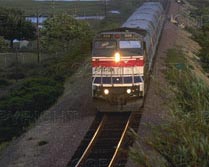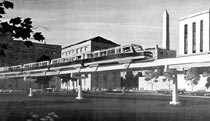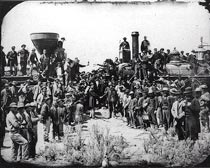| (insert your NIE or newspaper logo here) | Weekly Online LessonOnline Lesson ArchiveGrade Level: 7-10
|
All Aboard?
 Another major setback has Amtrak worried about its future.
Another major setback has Amtrak worried about its future.
On Wednesday, April 20, 2005, Amtrak (formally known as the National Railroad Passenger Corporation) announced that their Acela Express service has been stopped until summer to replace the cracked brakes on all 20 trains.
The Acela line has been providing high-speed intercity travel -- between New York, Boston and Washington D.C. -- since 2001. Although this incident marks the service's third major disruption, ridership had been rising and profits were covering operating expenses -- a rare occurrence in Amtrak's history of rail lines.
In the 1970, Congress created Amtrak to relieve freight train companies from the burden of providing unprofitable passenger service. Unfortunately, Amtrak itself hasn't been profitable either, and, since it's primarily owned by the U.S. Department of Transportation, has survived on big subsidies from the federal government.
Amtrak's system includes more than 22,000 route miles, mostly owned by freight railroads, and provides service to about 24 million passengers annually through most of the United States.
While train rides are generally pleasant, travel times to destinations are slower than by airplane. Often ticket prices are comparable, so the choice to fly usually trumps the scenic, longer route.
 In order to counter sky travel's swiftness, Amtrak had high hopes
for its Acela line. Inspired by the high-speed rail systems in Japan
and France, the plan was to create a faster American rail for intercity
travel.
In order to counter sky travel's swiftness, Amtrak had high hopes
for its Acela line. Inspired by the high-speed rail systems in Japan
and France, the plan was to create a faster American rail for intercity
travel.
Unfortunately, the new train design was severely flawed, plus the rails themselves remained the same -- made for the traditional, slow-moving freight cars and still used by them for transporting raw materials and goods.
Although the high-speed rail plan is stumbling along, trains -- carrying both materials and people -- have contributed greatly to the development of this nation. So for this week's lesson, you'll discover how the country's largest railway project, connecting the east and west coasts, became reality. You'll also take a look at how transportation has evolved and shaped our society.
The Transcontinental Railroad
 Let's begin by checking out the longest railroad route in the
United States -- the Transcontinental
Railroad.
Let's begin by checking out the longest railroad route in the
United States -- the Transcontinental
Railroad.
At this PBS site, click the Interactive Map to review The Race to Utah!
Read the introduction, then click The race is on! to follow the route from west to east. Explore each point with an orange marker to learn more about that place and time period.
What were some of the challenges each of the railroad companies faced? Why did Thomas Durant delay the east-to-west construction? In what ways did the labor force and environmental conditions differ between the two?
To learn more about the effects of the Transcontinental Railroad, browse the site's other sections, including the Timeline, the Scouting Album, Native Americans, and the People & Events.
How exactly did the railroad contribute to the economic, political and social successes of the United States and its people? In what ways did the railway change the landscapes and the native peoples? Why were some parts of the original rail line abandoned?
 To see how today's railroad system supports the nation, check
out The
Great Train Story at the Museum of Science and Industry.
To see how today's railroad system supports the nation, check
out The
Great Train Story at the Museum of Science and Industry.
Take the Tour from Seattle Harbor to Chicago. In what ways do people rely on railway transportation? What would be the alternatives, if the rail system didn't exist? Have you ever seen trains or tracks in your neighborhood or city?
America On the Move
Explore the Smithsonian Exhibition to start your journey into the history of American transportation and find out how it affected the nation and its people.
Begin with Transportation in America before 1876, and follow the Continue buttons through the site's different sections:
How has the different ways of transporting people and goods shaped our regional and national cultures and lifestyles over time? In what ways has it changed Americans' expectations of what kinds of items they can purchase, or how long it should take to travel from one point to another?
In what ways does the transportation of people, resources and goods affect your own life? What do you think would happen if modes of transportation suddenly reverted to the days before the Transcontinental Railroad? What factors influenced the evolution of transportation, as well as our reliance on it?
Newspaper Activities
In current issues of The Salt Lake Tribune look for articles on topics related to transportation, especially rail-related. Is Amtrak's future making news? If so, has the federal government decided to continue supporting the company or cut subsidies altogether? Are the Acela Express trains due to return or will Amtrak attempt a new plan? Is your city dealing with traffic congestion? If so, are local planners proposing any new roads or alternative public transit systems? Also, look for any news that features transit changes in how goods or raw materials are moved to and from your town.
© Copyright 2005
Learners Online, Inc.
